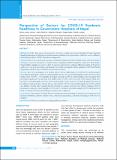Please use this identifier to cite or link to this item:
https://hdl.handle.net/20.500.14356/1241Full metadata record
| DC Field | Value | Language |
|---|---|---|
| dc.contributor.author | Hamal, Pawan Kumar | - |
| dc.contributor.author | Pokhrel, Nabin | - |
| dc.contributor.author | Pandey, Dipendra | - |
| dc.contributor.author | Malla, Pragya | - |
| dc.contributor.author | Lamsal, Ritesh | - |
| dc.date.accessioned | 2023-05-03T08:26:47Z | - |
| dc.date.available | 2023-05-03T08:26:47Z | - |
| dc.date.issued | 2020 | - |
| dc.identifier.citation | HamalP. K., PokhrelN., PandeyD., MallaP., & LamsalR. (2020). Perspective of Doctors for COVID-19 Pandemic Readiness in Government Hospitals of Nepal. Journal of Nepal Health Research Council, 18(2), 166-171. https://doi.org/10.33314/jnhrc.v18i2.2811 | en_US |
| dc.identifier.issn | Print ISSN: 1727-5482; Online ISSN: 1999-6217 | - |
| dc.identifier.uri | http://103.69.126.140:8080/handle/20.500.14356/1241 | - |
| dc.description | Original Article | en_US |
| dc.description.abstract | Abstract Background: The study assesses the perspective of doctors working in government hospitals of Nepal regarding hospital preparedness for infection prevention measures, isolation services provisions, critical care service readiness, and training of staff for COVID-19 pandemic management. Methods: This cross-sectional study was done in central, provincial, and local level health centers of the Government of Nepal to assess the perspective of medical doctors regarding COVID-19 pandemic readiness in their facility. Nonprobability sampling was used to collect 56 responses from doctors working in different hospitals of Nepal. An online survey was performed using a questionnaire tool, which was adapted from the guidelines of the World Health Organization and the Centers for Disease Control and Prevention. Results: Most of the participants were medical officers with an MBBS degree (32) followed by anesthesiologists (10). Thirteen participants worked in central hospitals (23.2%), 24 in provincial hospitals (42.8%) and 19 in local health centers (33.92%). The availability of adequate facemask was 84% in central hospitals, which was higher than provincial hospitals (66.7%), and local level health centers (77.8%). There were only 53.8% trained critical care providers in central hospitals and 29.2% in provincial hospitals. Nearly 38.5% (5) of central hospitals had measures for airborne isolation in place, whereas this was only found in 8.3% (2) of provincial hospitals surveyed for critical care facilities. Overall, only 2 hospitals had the provision of a negative pressure room with air exchanges. Only 8 participants working in central hospitals (61.5%) and 14 working in provincial hospitals (58.3%) had performed hands-on training for donning and doffing personal protective equipment. Conclusions: The majority of medical doctors working in government hospitals of Nepal perceive that provision of facemask distribution, airborne isolation rooms, critical care preparedness, and hands-on training to staff were not adequate. Keywords: COVID-19; Government of Nepal; pandemic; readiness. | en_US |
| dc.language.iso | en | en_US |
| dc.publisher | Nepal Health Research Council | en_US |
| dc.relation.ispartofseries | Apr-June, 2020;2811 | - |
| dc.subject | COVID-19 | en_US |
| dc.subject | Government of Nepal | en_US |
| dc.subject | pandemic | en_US |
| dc.subject | readiness | en_US |
| dc.title | Perspective of Doctors for COVID-19 Pandemic Readiness in Government Hospitals of Nepal | en_US |
| dc.type | Journal Article | en_US |
| local.journal.category | Original Article | - |
| Appears in Collections: | Vol. 18 No. 2 Issue 47 Apr-Jun 2020 | |
Files in This Item:
| File | Description | Size | Format | |
|---|---|---|---|---|
| 2811-Manuscript-17507-1-10-20200911.pdf | Fulltext Download | 259.62 kB | Adobe PDF |  View/Open |
Items in DSpace are protected by copyright, with all rights reserved, unless otherwise indicated.
